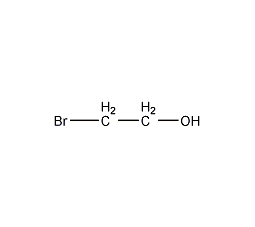
Structural formula
| Business number | 05K9 |
|---|---|
| Molecular formula | C2H5OBr |
| Molecular weight | 124.96 |
| label |
Bromoethanol, Beta-bromoethanol, 2-bromoethanol, Ethylene bromide, Ethylene bromohydrin, 2-Bromo-1-ethanol, 2-Bromoethyl alcohol, Aliphatic alcohols, ethers and their derivatives |
Numbering system
CAS number:540-51-2
MDL number:MFCD00002827
EINECS number:208-748-1
RTECS number:KJ8225000
BRN number:878140
PubChem ID:None
Physical property data
1. Properties: Colorless or light yellow hygroscopic liquid, its aqueous solution has a sweet burning smell. [1]
2. Boiling point (℃): 149~150[2]
3. Relative density (water =1): 1.763[3]
4. Relative vapor density (air=1): 4.3[4]
5. Saturated vapor pressure (kPa): 2.67 (57℃)[5]
6. Octanol/water partition coefficient: 0.23[6]
7. Flash point (℃): 40[7]
8. Solubility: miscible with water, miscible with ethanol , ether and most other organic solvents. [8]
Toxicological data
1. Acute toxicity: Mouse intraperitoneal LDLo: 80 mg/kg, no detailed description except the lethal dose;
2. Oncogenic data:
Mouse via Oral TDLo: 43 gm/kg/80W-C, tumor-equivocal tumor, RTECS standard gastrointestinal tract-tumor;
Mouse intraperitoneal TDLo: 150 mg/kg/8W-I, tumor-tumor RTECS standard, lung, chest or respiratory – tumor;
3. Mutagenicity data: Microbial body TEST system mutation: Bacteria – Salmonella typhimurium: 1 mg/plate; DNA repairTEST system: Bacteria – E. coli: 10 umol/plate; mutant microorganismsTEST system: Bacteria – Klebsiella pneumoniae: 15 mmol/L.
4. Its vapor irritates the eyes and mucous membranes, and the minimum lethal concentration (MLD) in the abdominal cavity of mice is 80 mg/kg.
5.Others[9] LDLo: 80mg/kg (mouse abdominal cavity)
Ecological data
1. Ecotoxicity No data available
2. Biodegradability No data available
3. Non-biodegradability No information yet
Molecular structure data
1. Molar refractive index: 20.58
2. Molar volume (cm3/mol): 72.2
3. Isotonic specific volume (90.2K ): 180.5
4. Surface tension (dyne/cm): 39.0
5. Polarizability (10-24cm3): 8.15
Compute chemical data
1. Reference value for hydrophobic parameter calculation (XlogP): None
2. Number of hydrogen bond donors: 1
3. Number of hydrogen bond acceptors:1
4. Number of rotatable chemical bonds: 1
5. Number of tautomers: none
6. Topological molecule polar surface area 20.2
p>
7. Number of heavy atoms: 4
8. Surface charge: 0
9. Complexity: 10
10. Number of isotope atoms :0
11. Determine the number of atomic stereocenters: 0
12. Uncertain number of atomic stereocenters: 0
13. Determine the chemical bond configuration Number of centers: 0
14. Number of uncertain chemical bond stereocenters: 0
15. Number of covalent bond units: 1
Properties and stability
1. Aqueous solutions can accelerate hydrolysis when exposed to acid, alkali and heating. High heat releases toxic gases and promotes hydrolysis in the presence of acids and alkalis.
2. Stability[10] Stable
3. Incompatible substances[11] Strong acid, strong reducing agent, strong oxidizing agent, acid anhydride, acid chloride
4. Conditions to avoid contact[12] Heating
5. Polymerization hazard[13] No polymerization
6. Decomposition products[ 14] Hydrogen bromide
Storage method
Storage Precautions[15] Stored in a cool, ventilated warehouse. Keep away from fire and heat sources. Keep container tightly sealed. They should be stored separately from oxidants, reducing agents, alkalis, and food chemicals, and avoid mixed storage. Use explosion-proof lighting and ventilation facilities. It is prohibited to use mechanical equipment and tools that are prone to sparks. The storage area should be equipped with emergency release equipment and suitable containment materials.
Synthesis method
Obtained from the reaction of ethylene oxide and hydrogen bromide: Pour ethylene oxide into a 46%-48% hydrobromic acid solution at 0-20°C. After the passage is completed, react for 1-2 hours. Neutralize the hydrobromic acid with sodium carbonate at about 10°C, extract 2-bromoethanol with diethyl ether, dry the diethyl ether solution with anhydrous magnesium sulfate overnight, filter out the desiccant, and recover the diethyl ether to obtain the crude product. The finished product is obtained by fractionation under reduced pressure.

Purpose
Used in organic synthesis and as solvent. [16]



